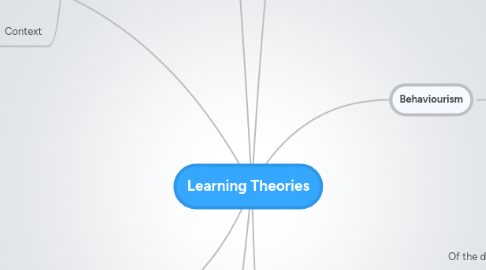
1. Pedagogy and Content Knowledge
2. Cognitivism
2.1. "Mind as a computer"
2.2. Prior Knowledge
2.2.1. Schema
2.2.2. Scaffolding
2.3. Atkinson-Shiffrin Memory Model
2.3.1. Sensory Memory
2.3.2. Short Term Memory
2.3.2.1. Working Memory
2.3.3. Long Term Memory
2.4. Symbolism
2.5. Organization
2.5.1. Prezi
2.5.2. Mind Maps
2.5.3. Layout
2.6. Cognitive Load Theory
2.6.1. Over Load Working Memory
2.6.1.1. Extraneous Cognitive Load
2.6.1.1.1. Manner information is presented
2.6.1.2. Intrinsic Cognitive Load
2.6.1.2.1. Learning Task
2.6.1.3. Germane Cognitive Load
2.6.1.3.1. Processing information and making schemas
2.6.2. Under Load Working Memory
2.6.3. Limits of working memory
2.7. Learning in context
2.8. Similarity to Constructivism: Both theories build off of previous knowledge or experiences
3. Constructivism
3.1. Mind as a network
3.2. Learning to build connections
3.3. Learning by interacting with the environment
3.4. Discover to learn
3.5. Construct knowledge from experiences
3.6. Teacher is the facilitator
3.7. Teach basic skills while learning curriculum
3.8. Projects
3.8.1. Lego Robotics
3.8.2. Learning by making
3.9. Vygotsky's Zone of Proximal Development
3.10. Similarity to Connectivism: Both build knowledge by building connections and networks between different knowledge and concepts
4. TPACK
4.1. TPCK
4.1.1. Ability to combine technology, pedagogy and content into classroom learning
4.1.1.1. Understand all of their individual complexities
4.1.1.1.1. Relationships between all three knowledges
4.1.1.1.2. Relationship by means fo teachers and their students
4.1.2. Conceptualize technology in learning
4.1.2.1. Technology influences pedagogy and content
4.2. Technology Knowledge
4.2.1. Technology integration
4.2.1.1. The tool doing what the teacher needs
4.2.1.2. Student friendly
4.2.2. Examples: Internet, netbooks, digital media
4.2.3. Digital literacy
4.2.3.1. Prepare for the future
4.2.4. Enhance learning
4.2.5. Purposeful us of technology in the classroom
4.3. Technology and Content Knowledge
4.3.1. How to use technology to teach different subjects
4.3.2. Examples: Animations, Videos, etc
4.3.3. New ways to teach students new content
4.4. Technological & Pedagogy Knowledge
4.4.1. Benefits of technology to enable teachers to teach
4.4.1.1. Assist teachers to perform
4.4.1.2. Technology makes sense to the diverse learners
4.5. Pedagogy Knowledge
4.5.1. Knowledge of "How Students Learn"
4.5.2. Teaching Methods
4.5.3. Assessment
4.5.4. Learning Theories
4.5.5. Overlaps with content knowledge
4.5.6. Is the task suited to the learners?
4.6. Pedagogy & Content Knowledge
4.6.1. How to combine pedagogy and content in an effective way
4.6.2. How to make a subject "learnable"
4.6.2.1. h
4.6.3. Pedagogical strategies of the task
4.6.4. Example: Using repetition to learn math
4.6.5. How to teach is dependant on the subject
4.7. Content Knowledge
4.7.1. Understanding of Knowledge
4.7.1.1. Concepts
4.7.1.2. Theories
4.7.1.3. frameworks
4.7.2. Know the subject
4.7.3. What you are teaching
4.7.4. Overlaps with pedagogy knowledge
4.7.5. Scaffolding
4.8. Context
4.8.1. Grade-level
4.8.2. School
4.8.3. Cultures
4.8.4. Class outcomes
4.8.5. Limited by environment
5. Behaviourism
5.1. Reinforcement
5.1.1. Positive
5.1.1.1. Rewards
5.1.1.2. Increase possibility of repeating the response
5.1.2. Negative
5.1.2.1. remove undesired responses
5.1.3. Learning oriented by results
5.1.4. stimulus to strengthen learning
5.2. Pavlov
5.3. Teacher-directed
5.3.1. Direct instruction
5.3.2. Example: Lecture
5.4. Stimulus response
5.4.1. repetition
5.4.1.1. drill
5.4.2. practice
5.4.2.1. example: math blaster
5.5. Modelling
5.6. Mind as a "Blank Slate"
5.7. Behaviour analysis
5.7.1. Behaviour as the site of learning
5.8. Environment
5.8.1. Primary influence to learning
5.8.2. determines behaviour
5.9. Similarity to Cognitivism: Both build knowledge from practicing for retention.
6. Connectivism
6.1. Of the digital age
6.2. Knowledge as connections
6.2.1. connections formed by experiences
6.2.2. sources
6.2.3. Diverse Opinions
6.2.4. Learning by connecting information
6.3. Technology
6.3.1. Social Networks
6.3.1.1. Twitter
6.3.1.2. Facebook
6.3.2. Search Engines
6.3.2.1. Google
6.3.2.2. Yahoo
6.3.3. Communication Tools
6.3.3.1. E-mail
6.3.3.2. Instant Messaging
6.3.4. Data Storage
6.3.4.1. Databases
6.3.4.2. Servers
7. Philosophy of Teachnology
7.1. Teachers goals to use technology
7.1.1. Incorporate Technology in the Classroom
7.1.1.1. Teachers use of technology to enable learning
7.1.1.2. Encourage students to use technology to encourage personal learning
7.2. Informed by TPACK
7.2.1. Technology knowledge
7.2.2. Technology & Pedagogy knowledge
7.2.3. Technology & Content knowledge
7.3. Teachers individual beliefs about how technology should be used
7.3.1. Beliefs about personal teaching practices
